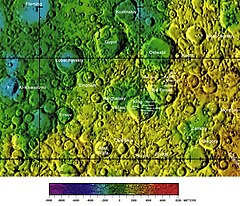Ostwald (moon crater)
| Ostwald | ||
|---|---|---|

|
||
| Taken from Apollo 16 (north is top right; bottom right of the picture is the right crater with a diameter of 20 km) | ||
|
|
||
| position | 10.4 ° N , 121.9 ° E | |
| diameter | 104 km | |
| depth | 3900 m | |
| Card sheet | 65 (PDF) | |
| Named after | Wilhelm Ostwald (1853-1932) | |
| Named since | 1970 | |
| Unless otherwise stated, the information comes from the entry in the IAU / USGS database | ||


Ostwald is an impact crater over 100 km in diameter. It is located about 300 km north of the equator on the far side of the moon a little more than 1,000 km to the east of the extreme eastern edge of the near side of the moon lying moon crater Napier . To the west of it is the Guyot crater and immediately south of Ibn Firnas . The right crater, five times smaller with a diameter of 20 km, is prominently located near its eastern crater rim .
The shape of the crater is almost circular with an irregular edge and a slightly southerly offset and less pronounced central mountain . The crater floor is relatively flat with traces of landslides and is covered by a large number of smaller impact craters. A short chain of craters forms a crevice in the western interior. There are some low ridges to the south and northeast of the center point.
Before being named after the German-Baltic chemist , philosopher and Nobel Prize winner for chemistry (1909) Wilhelm Ostwald (1853–1932) by the IAU in 1970, it was known as Crater 212 .
| Letter | position | diameter | link |
|---|---|---|---|
| Y | 13.49 ° N , 121.21 ° O | 27 km | [1] |
Web links
- Ostwald in the Gazetteer of Planetary Nomenclature of the IAU (WGPSN) / USGS
- Ostwald on The-Moon Wiki
Individual evidence
- ^ Ostwald in the Gazetteer of Planetary Nomenclature
- ↑ Lunar Farside Chart (LFC-1A)

